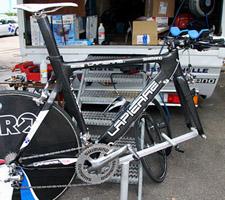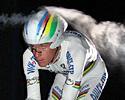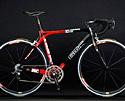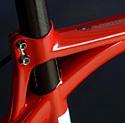
Recently on Cyclingnews.com |
Tour de France Tech – July 2, 2005Edited by John Stevenson Got tech? Send press releases, news, and tech questions to the Cyclingnews tech desk. Choose your weapons for an Aussie TT showdown
Among the contenders for today's 19km Tour de France are two of the world's best riders against the clock, Australians Bradley McGee (Francaise des Jeux) and Michael Rogers (Quick Step). McGee has long excelled at the shorter distances of prologues and the 4000m pursuit on the track, while Rogers has twice been world time trial champion. At 19km, this Tour's opening time trial is an unusual distance. Too short to be called a prologue, but not long enough to be a deep endurance test, it will nevertheless require total focus and commitment.
Both riders will be rolling out on relatively new bikes for this test. Rogers recently spent some time in the wind tunnel on Time's new RXR, while McGee will be aboard a custom carbon rig carrying the decals of his bike supplier, French manufacturer Lapierre. Time has gone all-out in its effort to back Rogers this year. It's no big secret that the world TT champ had previously used another maker's bike with Time decals on, but the RXR is a total effort to give Rogers the air-slicing machine he needs to make a difference both in the Tour time trials and to have any chance of a high place on GC. (See our previous story on Time's preparations for Rogers' TT bike.) As well as the aero frame, Rogers' Time has Fulcrum wheels - disc rear, deep-rim front - to carve through the wind, and an adjustable carbon aero bar of mysterious origin, with built-in brake levers. Like many recent TT bars, Rogers' rig uses 'S-bend' extensions, a shape that has swept through time trialling in the last year or so in the same way that aero bars originally blew into the TT world back in the 80s.
The bar is mounted in a carbon Time stem which in turn steers Tim's all-carbon fork. Other equipment carrying Rogers' TT hopes includes Campagnolo Record transmission components, Time pedals, and a Selle San Marco saddle. While you'll be able to buy an RXR for your own against-the-clock efforts (provided you have, we suspect, fairly deep pockets), there's no word yet from Lapierre as to whether the carbon fiber time trial bike McGee will roll out today is available to the rest of us. The aero business end of McGee's rig is Ritchey's new Hammerhead time trial bar, with S-bend extensions and an extremely minimal design. There's no fluff to the Hammerhead, just the bare essentials needed to get the rider into position for an all-out effort.
Entertainingly, McGee's bar is mounted in a Ritchey 'Severe Condition' stem, a component more usually seen on freeride and downhill mountain bikes. Lapierre's mechanics clearly don't expect McGee to be pulling any radical moves on this bike - rather the SC stem is very stiff, which helps when you're attaching a long aero bar to it. Or maybe it was just the first one to hand in a 31.8mm clamp!
Except for the Pro rear disc wheel, the rest of McGee's running gear is Shimano Dura-Ace, and when the team mechanic has finished working on it, it'll have a carbon-rimmed Dura-Ace front wheel. If the big selection of spare rings in the FDJ workshop truck is any indicator, it'll also have whatever chainring McGee deems exactly right for the conditions - which are expected to be windy. More info: www.cycles-lapierre.fr and www.timesportusa.com More photos of Rogers' and McGee's bikesImages by Anthony Tan/Cyclingnews
Orbea in time
And here's yet another new and sumptuous example of the carbon moulder's art, Orbea's Ordu time trial bike, which will make its first appearance today under Iban Mayo and the Euskaltel-Euskadi team at the Tour. In the language of Mayo's and Orbea's home in the Basque country, 'Ordu' means 'time' and Orbea says the new bike is designed to waste as little of it as possible between start and finish line. "Every detail of the carbon fiber frame was designed to guarantee optimum aerodynamic penetration," says Orbea USA's Adam Vincent. "Tubing shapes are aerodynamically superior and the complex design enclosing the rear wheel ensures a smooth transition from frame to wheel. Wind tunnel testing in Milan, Italy confirms the Ordu performs." Mayo has had a very quiet year so far, perhaps indicating that he learned his lesson last year when he hit storming form for the Dauphiné Libéré but hit a disastrous flat spot in the Tour. Assuming Mayo is more wisely prepared in 2005, he will be a threat in the mountains and if a new time trial bike saves precious seconds against the clock, he could be an overall contender. More info: www.orbea-usa.com Phonak gets new BMCs for the Tour
Swiss bike maker BMC launched its new Pro Machine race frame at the Tour and is claiming a first - the first frame built using Easton's carbon nanotube composite technology. The carbon in conventional carbon composites is simply arranged as linear strands - it's the carbon 'backbone' that's left behind when the side atoms are removed from a polymer molecule. A few years ago, scientists discovered that as well as familiar forms such as diamond and graphite, carbon could also arrange itself in the form of 'buckyballs' - spherical molecules in which 60 or more carbon atoms were arranged in a structure rather like a Buckminster Fuller dome. That suggested that maybe carbon could also be persuaded to form tubes, and in the last couple of years materials technologists have figured out how to make tiny but immensely strong carbon tubes. It's this form of carbon that Easton is exploiting in its new composites, and the new material has allowed BMC to make its first sub-kilo frame.
As well as a new material, BMC has introduced new construction details for the Pro Machine. According to the company, only one part of the frame is aluminium: the bottom bracket shell. Traditional 'hard points' such as the dropouts, seat cluster and head tube are all carbon fiber. Even the cable guides are moulded into the frame structure, not glued on afterwards. More info: www.bmc-racing.com |
|||||||||||









